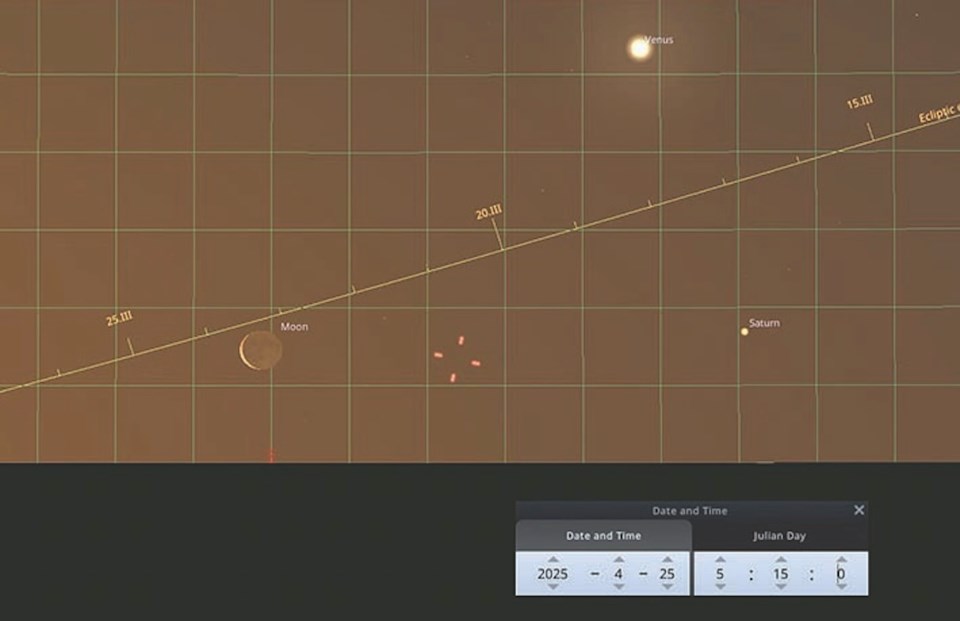This month Venus and Mercury have moved to the morning sky after March’s evening appearances. Unfortunately, the ecliptic is pretty low to the west of the Sun for us in the Northern Hemisphere and while we’ll see Venus as it pulls away from the Sun, Mercury is just too close and too low for good viewing. Venus is still visible as a thin crescent through binoculars during most of April, although it shrinks and the illuminated portion of its disc grows as it pulls away from us.
The last Friday of the month, April 25, shows an interesting view to the east just before sunrise at about 05:15. The attached Stellarium screenshot shows the thin waning crescent Moon (just before New Moon), Venus above and right as the “Morning Star” after its inferior conjunction on March 22 and below Venus and slightly to the right, the planet Saturn about 2 degrees above the horizon –– same height as the Moon. Saturn’s rings were edge-on to us last month and are only just beginning to open up to show us their south side as Saturn slowly swings around the Sun. I have tried to see the rings with binoculars in the past and even with 15 x 70’s I’ve never managed it. With Saturn so close to the horizon, I’m not even sure how good a telescope view would be. It might be possible, however, to see Saturn’s big moon Titan about 45 degrees left and below the planet and about 3 arcminutes away (about one-tenth the diameter of the Moon). All that atmosphere between us and Titan may dim it down to below the visual magnitude limit for binoculars but a good scope –– 6” or bigger –– might show it. If Titan shows up, and that might well be a big if, there’s another target about 60 per cent of the way back towards the Moon: the planet Neptune. Its location is shown by the little partial crosshairs in the screenshot. It would be a little brighter than Titan, possibly too faint for binocs but visible in any telescope that’ll show Titan and would appear as a tiny blue disc. In the interests of full disclosure, I’ll admit that I’ve never seen Neptune that I know of, and Titan only rarely and never in binoculars. Anyone who can pull off these two deserves a standing ovation. I do complain that while increasing arthritis and dimming vision truly suck, it does beat the alternative of not getting any older.
This year has been a pretty good one for seeing Mars; it was at opposition in mid-January and its closest approach to Earth for the year. While we normally see the outer planets moving from west to east through the sky relative to the stars behind – known as prograde motion – when they near opposition, they appear to slow, stop and move in the opposite direction – east to west, known as retrograde motion. That’s the reason the ancient Greeks gave them name of planets, meaning “wanderers.” It’s simply an illusion, however, one that becomes entirely obvious once one realizes that our planet is also moving around the Sun and doing so faster than the planets farther away from the Sun. Mars stopped below and left of the Castor/Pollux pair of stars, then started moving up and right until it was west of them and forming a right angle then slowed, stopped and started moving east again –– prograde. It will be passed by the Moon on April 5 and continue moving east until it’s exactly in line with Castor and Pollux again on April 10.
Jupiter has been bright and beautiful high in the sky since its opposition in December but our motion around the Sun is leaving it behind and it’s sinking towards the Sun as the month progresses. By the end of April, it’s heading eastward, slowly leaving Taurus and its bright star, Aldebaran and being overtaken by the setting Sun. At about 21:30 on April 30 Jupiter will be about 20 degrees above the horizon, slightly north of due west and directly below the waxing crescent Moon. Jupiter’s four big moons will also be quite close to the planet around April 14 to 16 and again on April 25, for those who have access to a telescope.
Yes, we’re still waiting for the predicted flareup of T Corona Borealis. Check its brightness goings-on and many other events at spaceweather.com.
The next Sunshine Coast Astronomy Club monthly meeting will be at the Sechelt Library, April 11, at 7 p.m. The speaker will be Dr. Michelle Kunimoto from UBC who will be describing the search for exoplanets.



